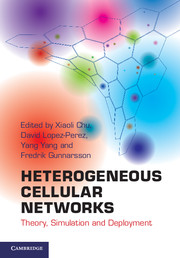Book contents
- Frontmatter
- Contents
- Acknowledgments
- Forewords
- Preface
- List of contributors
- Acronyms
- 1 Introduction
- 2 Radio propagation modeling
- 3 System-level simulation and evaluation models
- 4 Access mechanisms
- 5 Interference modeling and spectrum allocation in two-tier networks
- 6 Self-organization
- 7 Dynamic interference management
- 8 Uncoordinated femtocell deployments
- 9 Mobility and handover management
- 10 Cooperative relaying
- 11 Network MIMO techniques
- 12 Network coding
- 13 Cognitive radio
- 14 Energy-efficient architectures and techniques
- Intex
6 - Self-organization
Published online by Cambridge University Press: 05 June 2013
- Frontmatter
- Contents
- Acknowledgments
- Forewords
- Preface
- List of contributors
- Acronyms
- 1 Introduction
- 2 Radio propagation modeling
- 3 System-level simulation and evaluation models
- 4 Access mechanisms
- 5 Interference modeling and spectrum allocation in two-tier networks
- 6 Self-organization
- 7 Dynamic interference management
- 8 Uncoordinated femtocell deployments
- 9 Mobility and handover management
- 10 Cooperative relaying
- 11 Network MIMO techniques
- 12 Network coding
- 13 Cognitive radio
- 14 Energy-efficient architectures and techniques
- Intex
Summary
Introduction
Heterogeneous cellular network (HCN) deployments may imply an order of magnitude more network nodes than conventional homogenous macrocell deployments. Therefore, it is important that the integration and operation of these new nodes require minimal manual efforts from operators. Self-organizing network (SON) features can be seen as essential enablers to facilitate service as well as network deployment and management. The main objectives of SONs are to reduce the deployment costs, simplify network management (managing a plethora of radio access technologies (RATs) without significantly increasing operational expenses) and enhance network performance.
Within the 3rd Generation Partnership Project (3GPP) Long Term Evolution (LTE), SON was among the early system requirements, and SON features were already included in the first 3GPPLTErelease, i.e., Release 8 [1]. SONwork items in 3GPP [2, 3] have been inspired by the SONstudies and the set of requirements defined by the operators' alliance Next Generation Mobile Networks (NGMN) [4]. This chapter addresses HCN aspects of SON, although these automation features are applicable to other types of network deployment aswell. Themain focus is on LTE, but Universal Mobile Telecommunication System (UMTS) and multiple RATs will also be considered where applicable. More general discussions about SON can be found in [5–9], and a discussion with special focus on femtocells can be found in [10].
SON operations are supported by the operation, administration, and maintenance (OAM) architecture, which is presented in Section 6.2, and are commonly divided into four key components/phases: planning, self-configuration, self-optimization and selfhealing, as illustrated in Fig. 6.1.
- Type
- Chapter
- Information
- Heterogeneous Cellular NetworksTheory, Simulation and Deployment, pp. 145 - 178Publisher: Cambridge University PressPrint publication year: 2013
- 4
- Cited by



